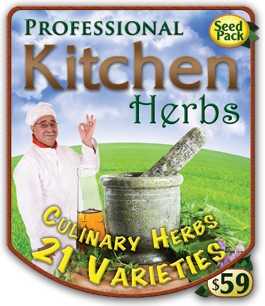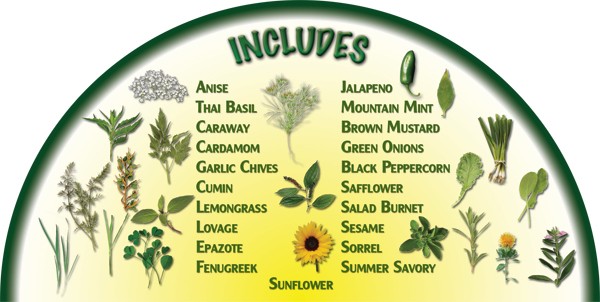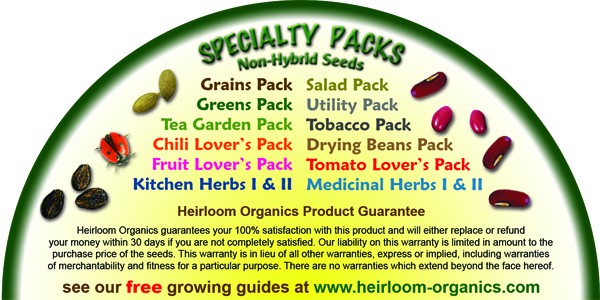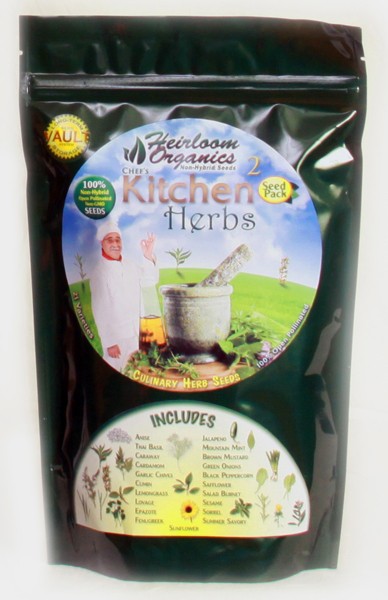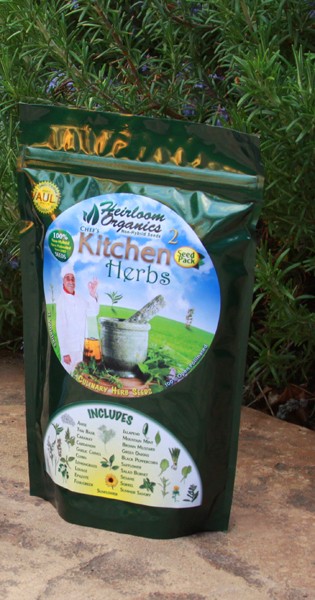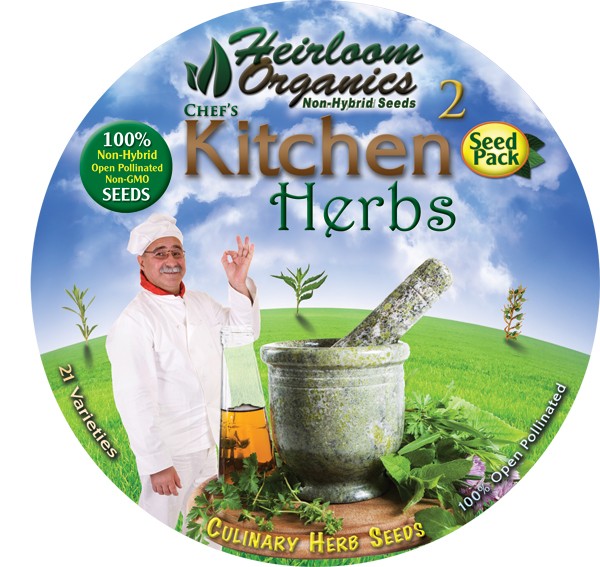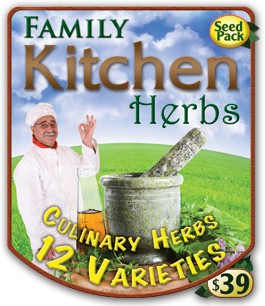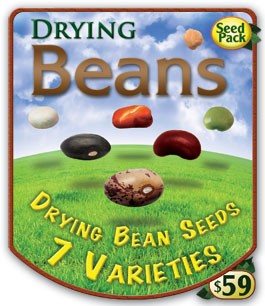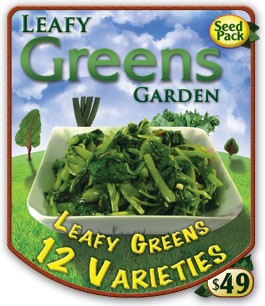Product Description
 Anise Pimpinella anisum
Anise Pimpinella anisum
Though often compared to Fennel, Licorice and Tarragon, Anise has its own unique flavor that has been enjoyed around the Mediterranean and North Africa for thousands of years. The Romans placed such value on Anise that it was occasionally traded as a currency. Anise is most commonly used as a flavor in sweets and confections, and over the centuries has also been added to perfumes and breath fresheners.
 Basil, Thai Ocimum basilicum
Basil, Thai Ocimum basilicum
Thai Basil is unique among basil cultivars for its sweet, almost minty flavor. Like other basils, it is hardy to a wide range of conditions and once established will provide a steady supply of flavorful leaves throughout the growing season.
 Caraway Carum carvi
Caraway Carum carvi
Most commonly found in the cuisines of Eastern Europe, Caraway seeds are often added to breads, cakes, soups, cheeses, cabbages and other dishes to add a distinct and pungent flavor. It has been used for thousands of years, and by some accounts is the oldest known condiment. Interestingly, this seed was once a key ingredient in love potions as it was once said that anything containing Caraway could not be stolen.
 Cardamom Elettaria cardamomum
Cardamom Elettaria cardamomum
Cardamom is among the more popular aromatic herbs used today, with the seeds adding a uniquely sweet quality to many popular commercial beverages and other products. More traditionally, this botanical has been enjoyed in its native India for thousands of years in a wide array of dishes, deserts and teas. Cardamom was so revered in Scandinavia that following the opening of trade routes between the two regions, it quickly came to define the flavor of many traditional Nordic breads and sweets.
 Chives, Garlic Allium tuberosum
Chives, Garlic Allium tuberosum
Popular in the cuisines of Asia, Garlic Chives are sometimes used in place of regular chives or green onions to provide an extra shot of garlic flavor. Fast growing and aromatic, this annual herb produces showy white flowers, which can double as a mild seasoning when dried and crushed.
 Cumin Cuminum cyminum
Cumin Cuminum cyminum
Cultivated for millennia in North Africa, the Mediterranean and modern-day Iran, Cumin is now an essential flavor in the cuisines of Europe, India, Mexico and elsewhere. Seeds of this parsley family member have been recovered dating back more than 4000 years, and the seeds of this herbaceous annual are believed to be the second most popular spice in the world. The leaves can also be added to salad and impart a mild tangy flavor.
 Epazote Chenopodium ambrosioides
Epazote Chenopodium ambrosioides
Epazote is used in many traditional Mexican dishes including tamales, mole de olla, salsa, traditional black beans and enchiladas. Eaten fresh, it has a distinct strong and pungent taste and aroma that can be reminiscent of a wide variety of other tastes including: citrus, anise, fennel, mint or tarragon. Needless to say, Epazote can be an acquired taste. In Mexico, it is sometimes consumed as a leaf vegetable but more commonly dried and used as an herb.
 Fenugreek Trigonella foenum-graecum
Fenugreek Trigonella foenum-graecum
Fenugreek has traditionally been used in the preparation of pickles, chutneys and curry powders in its native India, where is has been used as a nutty and slightly bitter culinary seasoning for thousands of years. While the seeds are the most known and commonly used part of the plant, fresh Fenugreek leaves can make a flavor addition to salads or other raw dishes or dried and used with meat or poultry.
 Jalapeño Capsicum annum
Jalapeño Capsicum annum
Jalapeños and other red peppers, have been cultivated by man for over 7000 years, with fossil records indicating a history of human use extending back at least 2000 years prior to that. They are native to Central America where they have been prized for the heat and flavor they bring to the local cuisines. Adaptable to a wide range of conditions, Jalapeños are also prodigious producers, with a single plant capable of producing 35 or more fruiting pods.
 Lemon Grass Cymbopogon flexuosus
Lemon Grass Cymbopogon flexuosus
Lemon Grass is native to India, where the tangy citrus flavor provides mild relief from the sweltering local climates. Although it is most commonly added to curries, soups broths or as a tea, it can also add an exotic touch to poultry, fish and other main dishes. Relatively easy to grow, Lemon Grass is a tall grass family member that is perennial in warmer climates.
 Lovage Levisticum officinale
Lovage Levisticum officinale
Also known as love parsley, Lovage is a hardy perennial herb has an odor and taste that are often compared to parsley and celery. Nearly every part of this plant has found some culinary application over the centuries. The leafstalks are most commonly is the stalk which is often used interchangeably for celery. Additionally, the leaves can be added to soups, stews and other vegetable dishes while the root is sometimes grated and added to salads, icings, syrups and other concoctions. Lovage is also noted for its high content of quercetin, a plant flavanoid believed to have strong anti-inflammatory and antioxidant properties.
 Mint, Mountain Pycnanthemum pilosum
Mint, Mountain Pycnanthemum pilosum
Pungent and with a strong minty aroma, Mountain Mint can be used to flavor dishes such as lamb, fish, poultry & sauces, and can also be used in sweets and confections. Native to North America, Mountain Mint is also said to be a helpful addition to the herb garden for its ability to repel unwanted insects and deer.
 Mustard, Brown Brassica juncea
Mustard, Brown Brassica juncea
Mustard has been used as a seasoning and condiment for at least 2500 years, with the pungent and spicy taste of this seed finding favor in many cuisines across Europe and Asia. Today it is commonly mixed with water, vinegar and other spices to produce the popular condiment that is used to dress up sandwiches and other foods. Aside from its considerable culinary prowess, mustard seed is said to bring luck, and if worn or carried, protection from harm.
 Onions, Green Allium fistulosum
Onions, Green Allium fistulosum
Scallions, or Green Onions, are milder than their larger cousins are a common component in many Asian cuisines. Most commonly they are used in stir-fries, soups, curries, noodle and seafood dishes and salads. Easy to grow and quick to harvest, Green Onions are versatile and simple way of bringing traditional onion flavor to your kitchen.
 Peppercorns, Black Piper nigrum
Peppercorns, Black Piper nigrum
Black Peppercorn is native to India, where the seeds of this flowering vine have been used as a seasoning for thousands of years. Today it is the worlds most commonly traded and used spiced, pairing with salt on dinner tables across the US, Europe and elsewhere. Piper nigrum can also be used to produce white pepper by removing the dark outer seed coat, or green pepper by harvesting and drying immature seeds.
 Safflower Carthamus tinctorius
Safflower Carthamus tinctorius
Safflower was once used as less expensive replacement for Saffron, from which the name of this herbaceous annual is derived. More commonly, the seeds are pressed into oil that is used much like sunflower oil. The tender shoots also have use in salads and raw dishes, while the seeds may be consumed raw or roasted and added to cooked dishes.
 Salad Burnet Sanguisorba minor
Salad Burnet Sanguisorba minor
Salad Burnet is commonly used in salads and dressings, where it is enjoyed for a taste that reminds some of cucumber. Native to Europe, it is hardy to a wide range of conditions and will grow to a height of 16 inches or more and grow tiny white flowers.
 Savory, Summer Satureja hortensis
Savory, Summer Satureja hortensis
Summer Savory is popular along the eastern regions of Canada, where it is used in place of Sage to flavor various meat and poultry dishes. Bright, pungent, and slightly sweet, Savory has also been utilized in the cuisines of Europe, notably France and Bulgaria where the dried and crushed leaf is a popular table condiment.
 Sesame Sesame indicum
Sesame Sesame indicum
Well known in many traditional cuisines across Europe and Asia, Sesame is today popular across the globe. From bagels to sushi, these tiny seeds add a richness and texture that simply cannot be duplicated. Pressed oil of sesame, a mainstay in many Asian cuisines, is rapidly becoming more common in the United States thanks to its unique nutty flavor.
 Sorrel Rumex acetosa
Sorrel Rumex acetosa
Sorrel has been cultivated across Europe and North Africa for centuries, and the leaves of this hardy herbaceous green are most commonly used to impart flavor to soups, salad, and fish in French cuisine. In smaller quantities, the taste reminds some of citrus fruits or wild strawberries, with a slight edge. Sorrel leaves were used by the Romans to impart sharpness or acidity to foods.
Caution: Sorrel should only be consumed in small quantities to add flavor. In large doses, the presence of oxalic acid can be fatal.
 Sunflower Helianthus annuus
Sunflower Helianthus annuus
Tall and proud, Sunflower makes a stunning addition to the garden. In this pack, we offer Fat Mama seeds, a variety that produces massive flower heads and extraordinary yields of sunflowers that are delicious fresh, dried or pressed into oil. A hardy and quick grower that is sure to add cheer to the summer garden.
Due to ongoing seed shortages, seed varieties subject to change without notice. Replacements will be as close as possible and will be included in your order documentation.
– See more at: http://www.non-hybrid-seeds.com/sp/specialty-packs/kitchen-herb-pack-ii-59.html#sthash.wTBZ42hb.dpuf

